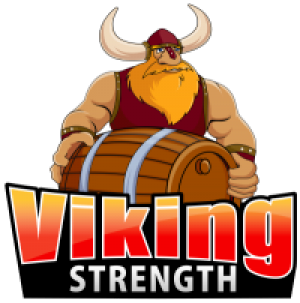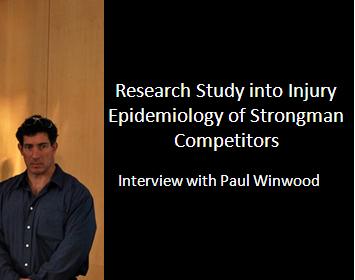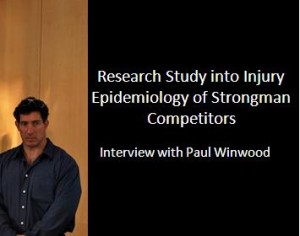Last week I came across a strongman survey which New Zealander Paul Winwood has put together for his PhD thesis.
I thought it would be good for him and for “us” strongmen to find out a little more about the survey and what he is using this to find out, in this research study into “Injury Epidemiology of Strongmen”.
I urge every competitor who reads this article to complete the study.
COMPLETE THE STUDY HERE.
Phil Burgess: The study is called “Injury Epidemiology of Strongmen” simply put, what does this mean?
Paul Winwood: The study’s title simply means that we are investigating the distribution, patterns and causes of injury associated with strongman training among strongman competitors.
The study asks strongman competitors of varying ages, body masses, competitive standards, and genders to complete a retrospective injury survey that includes questions on the nature of the number, anatomical location, cause of injury and type of injury; the manner in which the injuries affect training; and the rehabilitation procedures used to recover from injuries.
Phil Burgess: Have you done any similar studies to this before?
Paul Winwood: Yes, I published two studies last year from my Masters research with the help of my supervisors Justin Keogh and Nigel Harris. Here are the links to the abstracts:
http://www.ncbi.nlm.nih.gov/pubmed/21993033
http://www.ncbi.nlm.nih.gov/pubmed/22233785
The top link is the strongman training practices study which is similar type of study to this one in which we used a survey to gather the data.
Phil Burgess: Are there many scientific studies specific to strongmen?
Paul Winwood: Currently there are very few scientific studies done on the sport.
Most of the research so far has investigated the metabolic and biomechanical demands of strongman exercises (Berning, et al., 2007; Keogh, et al., 2010; Keogh, et al., 2010c; McGill, et al., 2009).
Another study has investigated the issue of practicality of overload in strongman training when dealing with large groups of athletes (Baker, 2008).
Phil Burgess: Do you have any thoughts on what you think the study will show?
Paul Winwood: Great question Phil! The study of McGill (2009) gave us some good insight into the possible stresses these events impose on the body.
The stone lift produced the greatest gluteal (i.e. gluteus maximus and gluteus medius) quadriceps, and upper erector spinae activity.
Whereas the tire flip produced the highest activation levels in the latissimus dorsi, the lower lumbar erector spinae and the hamstrings.
The yoke walk produced the highest muscular and spinal joint compression loads which may demonstrate that this event carries a high degree of injury risk with it.
Interestingly, the walking events (i.e. farmers walk, yoke walk, left and right hand suitcase carry) demonstrated greater activation of the abdominals (rectus 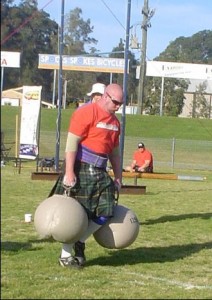 abdominis, internal and external obliques) than the lifting events.
abdominis, internal and external obliques) than the lifting events.
The study demonstrates that each strongman event is unique and stresses the body in a different way. However the study only gave us insight into the stresses of a few events.
It’s my belief that exercises such as the circus dumbbell would carry a high risk of shoulder injury i.e. rotator cuff tear, and the axle deadlift could be responsible for a few bicep tears.
Studies have investigated the injury epidemiology of power lifting and weightlifting events. Powerlifters are at risk from lower back injuries and weightlifters are at risk of knee injuries.
These differences are due to the different types of squats performed in the lifts. Both power lifting and weightlifting events are performed bilaterally with the load being moved in the vertical plane, which require the production of vertical ground reaction forces.
In contrast strongman events such as the Yoke walk and Farmers walk are total body movements performed in multiple planes and are performed unilaterally and require the production of horizontal as well as vertical ground reaction forces. It will be interesting to see the injury epidemiology data from these events!
The results of our study will provide comprehensive descriptive information about the injuries associated with strongman implement training which will help to provide a basis for injury prevention initiatives for strongman training.
Phil Burgess: What has personally motivated you to do this study?
Paul Winwood: The motivation came about through my passion for strength and conditioning and the fact that such little research has been done on this sport.
Currently strength and conditioning coaches are advocating the use of strongman implement training in the programs of their athletes without any scientific evidence of the risks and benefits of this type of training!
Phil Burgess: My experience with injuries is that I have suffered more when moving the weights (tidying up or loading car), than I have when training with them or competing. Do you think this is a common cause of injury in strongmen, or just my particular bad luck?
Paul Winwood: Another good question Phil, I know exactly where you are coming from. I have got a 600lb deadlift in competition without any injury, yet put my back out lifting an empty beer bottle from the ground!
I think when we are lifting/training we are very aware of keeping good technique and posture yet when we are doing everyday tasks we become complacent/less aware about body position and loading which puts us at risk of injuries.
Phil Burgess: How many people are you looking at completing the study, and how long would it take someone to complete?
Paul Winwood: The survey takes about 10 to 20 minutes to complete. I am hoping to get at least 200 strongman competitors to fill in the survey.
The more strongman competitors we can get to fill in the survey the more accurate picture we will get of the injuries and potential risks associated with strongman implement training.
Phil Burgess: Will you be sending a copy of the the results of the study to everyone who participates?
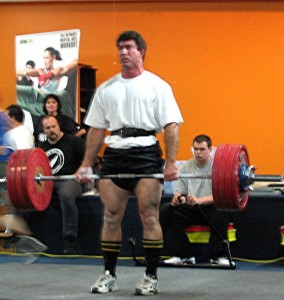
Paul Winwood: Because the study is anonymous I don’t know who has filled in the study or not. I have asked AUT (Auckland University of Technology) to post the results on their website.
Anyone that wishes to view the results can click on this link and go to research-results. I hope to publish the results in approximately 4 months time.
http://www.sprinz.aut.ac.nz/areas-of-expertise
